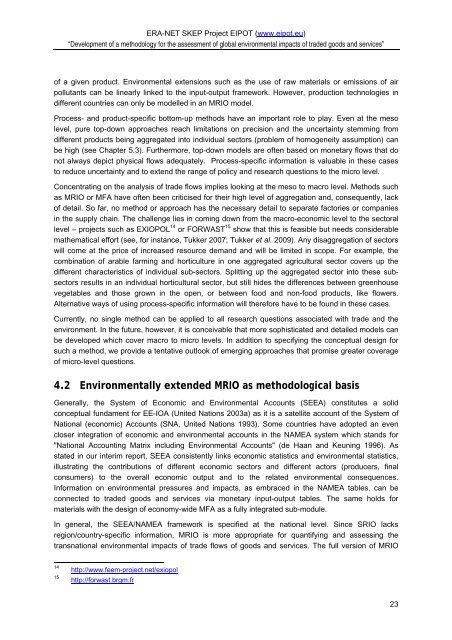EIPOT Final Project Report - Stockholm Environment Institute
EIPOT Final Project Report - Stockholm Environment Institute
EIPOT Final Project Report - Stockholm Environment Institute
You also want an ePaper? Increase the reach of your titles
YUMPU automatically turns print PDFs into web optimized ePapers that Google loves.
ERA-NET SKEP <strong>Project</strong> <strong>EIPOT</strong> (www.eipot.eu)<br />
“Development of a methodology for the assessment of global environmental impacts of traded goods and services”<br />
of a given product. <strong>Environment</strong>al extensions such as the use of raw materials or emissions of air<br />
pollutants can be linearly linked to the input-output framework. However, production technologies in<br />
different countries can only be modelled in an MRIO model.<br />
Process- and product-specific bottom-up methods have an important role to play. Even at the meso<br />
level, pure top-down approaches reach limitations on precision and the uncertainty stemming from<br />
different products being aggregated into individual sectors (problem of homogeneity assumption) can<br />
be high (see Chapter 5.3). Furthermore, top-down models are often based on monetary flows that do<br />
not always depict physical flows adequately. Process-specific information is valuable in these cases<br />
to reduce uncertainty and to extend the range of policy and research questions to the micro level.<br />
Concentrating on the analysis of trade flows implies looking at the meso to macro level. Methods such<br />
as MRIO or MFA have often been criticised for their high level of aggregation and, consequently, lack<br />
of detail. So far, no method or approach has the necessary detail to separate factories or companies<br />
in the supply chain. The challenge lies in coming down from the macro-economic level to the sectoral<br />
level – projects such as EXIOPOL 14 or FORWAST 15 show that this is feasible but needs considerable<br />
mathematical effort (see, for instance, Tukker 2007; Tukker et al. 2009). Any disaggregation of sectors<br />
will come at the price of increased resource demand and will be limited in scope. For example, the<br />
combination of arable farming and horticulture in one aggregated agricultural sector covers up the<br />
different characteristics of individual sub-sectors. Splitting up the aggregated sector into these subsectors<br />
results in an individual horticultural sector, but still hides the differences between greenhouse<br />
vegetables and those grown in the open, or between food and non-food products, like flowers.<br />
Alternative ways of using process-specific information will therefore have to be found in these cases.<br />
Currently, no single method can be applied to all research questions associated with trade and the<br />
environment. In the future, however, it is conceivable that more sophisticated and detailed models can<br />
be developed which cover macro to micro levels. In addition to specifying the conceptual design for<br />
such a method, we provide a tentative outlook of emerging approaches that promise greater coverage<br />
of micro-level questions.<br />
4.2 <strong>Environment</strong>ally extended MRIO as methodological basis<br />
Generally, the System of Economic and <strong>Environment</strong>al Accounts (SEEA) constitutes a solid<br />
conceptual fundament for EE-IOA (United Nations 2003a) as it is a satellite account of the System of<br />
National (economic) Accounts (SNA, United Nations 1993). Some countries have adopted an even<br />
closer integration of economic and environmental accounts in the NAMEA system which stands for<br />
"National Accounting Matrix including <strong>Environment</strong>al Accounts" (de Haan and Keuning 1996). As<br />
stated in our interim report, SEEA consistently links economic statistics and environmental statistics,<br />
illustrating the contributions of different economic sectors and different actors (producers, final<br />
consumers) to the overall economic output and to the related environmental consequences.<br />
Information on environmental pressures and impacts, as embraced in the NAMEA tables, can be<br />
connected to traded goods and services via monetary input-output tables. The same holds for<br />
materials with the design of economy-wide MFA as a fully integrated sub-module.<br />
In general, the SEEA/NAMEA framework is specified at the national level. Since SRIO lacks<br />
region/country-specific information, MRIO is more appropriate for quantifying and assessing the<br />
transnational environmental impacts of trade flows of goods and services. The full version of MRIO<br />
14<br />
15<br />
http://www.feem-project.net/exiopol<br />
http://forwast.brgm.fr<br />
23
















